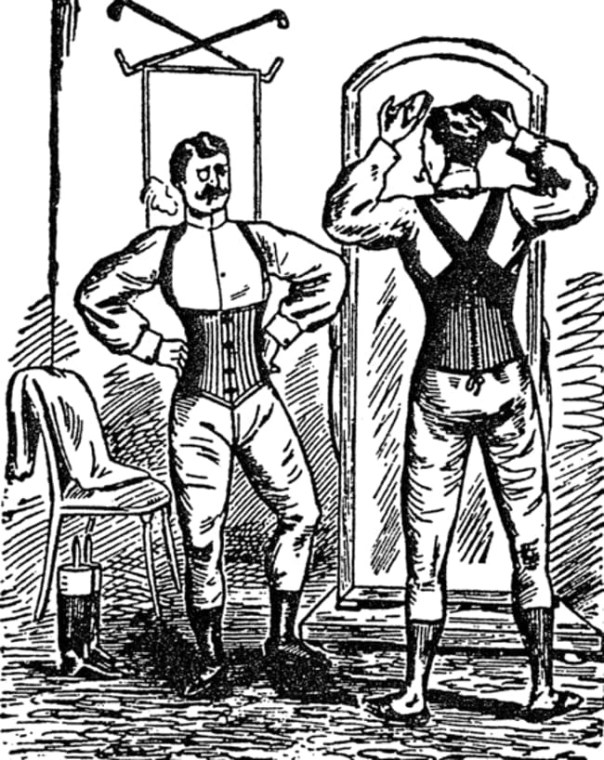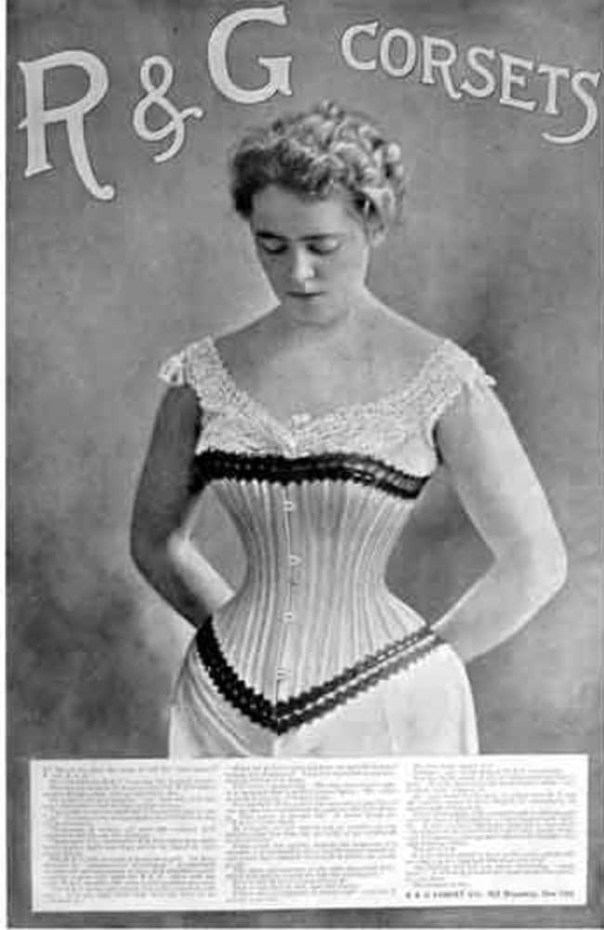Corsets became popular in the 16th century allegedly because Catherine de’ Medici, wife of French King Henry II, banned women with thick waists from attending court. She was a tyrannical monarch, but the Italian-born woman created beauty standards that held up exceptionally well. Corsets remained incredibly common during the Renaissance, up until the 20th century. Certain historians, however, suggested the restrictive undergarments contributed to the patriarchal system of female oppression.
The inherent tightness of the shapewear appealed to the male-dictated understanding of femininity and attractiveness. So unsurprisingly, women wore corsets to their own detriment. They suffered to achieve a smaller, more socially acceptable waist. Many 21st century beauty trends are as focused on the hourglass shape as well, but there are so many things people don’t know about corsets.
Napoleon Claimed Corsets Contributed To The Decline Of Humanity

Napoleon Bonaparte not only quested to rule Europe, he also campaigned to do away with corsets. The dictator called the shaping undergarment “the implement of detestable coquetry which not only betrays a frivolous bent but forecasts the decline of humanity.” And while Bonaparte’s female lovers still wore corsets, less hypocritical medical professionals believed the clothing could cause infertility. In fact, C.J. Dickinson, professor emeritus at Wolfson Institute of Preventive Medicine, says that extremely tight clothing may result in endometriosis, causing lesions on the uterus lining. When constricted, these lesions can’t shed during menstruation; internal bleeding may occur, and scar tissue might form.
Some Men Wore Corsets

Women were not the only aristocrats wearing corsets to create more socially acceptable figures. Specifically, in the latter part of the 18th century men wore form-fitting trousers and jackets. Corsets helped gentlemen achieve a smoother silhouette. However, French and Englishmen grew tired of the trend by the middle of the 19th century. Those who continued to wear the undergarments were teased.
Austrian men continued to wear corsets despite changing fashion standards in the rest of Europe, though. One English gentleman who attended an elite Austrian boarding school noted in the 1867 issue of The Englishwoman’s Domestic Magazine:
From personal experience, I beg to express a decided and unqualified approval of corsets. I was early sent to school in Austria where lacing was not considered ridiculous in a gentleman as in England, and I objected in the thoroughly English way. A sturdy [school attendant] was deaf to my remonstrance, and speedily laced me up tightly in a fashionable Viennese corset… It is from no feeling of vanity that I have ever since continued to wear them fro, not caring to incur ridicule, I take good care that my dress shall not betray me…
Some Corsets Contained Pieces Of Metal Or Bone
Corsets date back at least as early as the 16th century. Aristocratic women started to wear bodices reinforced with whale bones and tusks, instead of the original ones made from cloth and silk. Eventually, pieces of wood and metal were added to the front of most corsets to create even more structure. Duchess of Montpeniser Anne Marie Louise d’Orléans actually had a predominantly metal corset decorated with a crown and fleur-de-lis.
Some 19th-Century Medical Professionals Discouraged Tightly Laced Corsets

Not all citizens condoned corsets or the tight lacing that became popular once metal eyelets were added to the undergarments. In fact, Lancet, one of the oldest medical journals, produced a few articles about the dangers of corsets in the 1880s and ’90s. Additionally, The Sacred Heart Review mentioned in 1890:
Tight lacing] cannot be but hurtful… the veriest novice in anatomy understands how by this process almost every important organ is subjected to cramping pressure, its functions interfered with, and its relations to other structures so altered as to render it, even if it were itself competent, a positive source of danger to them.
Moreover, surgeon William Henry Flowers wrote in his 1881 book, Fashion in Deformity, that tightly-laced corsets were just as harmful as skull-shaping and foot-binding.
They Caused Breathing Problems

Women wore corsets for centuries, but when metal eyelets were added to the undergarments in the 1820s and 1830s, tight-lacing became incredibly popular. This trend involved threading the strings of the corset through the eyelets and pulling considerably. Women were able to be tied in without concern of reverting back to their natural forms. This tight-lacing allegedly caused young women to faint, though; their breathing was constricted. When ladies passed out from lack of oxygen, acquaintances loosened their corset laces or stays. Air then flowed more freely into the lungs. Certain analysts believe excessively tight clothing results in heartburn, distension, and varicose veins because of restricted blood flow.
Not All Corsets Were Used To Make The Waist Appear Slimmer

European corsets in the beginning of the 16th century created an exceedingly recognizable form. An aristocratic woman’s bosom was pushed upward when she wore the shaping garment; her upper half appeared fuller. The torso was shaped like a cylinder because of an unyielding material that ran down the front of the corset. The shaping devices looked more like cones in the 17th century, though. Two pieces of fabric with thick boning were combined to make the waist seem even more narrow.
From about 1800 to 1830, corsets were more forgiving. Women’s stomachs were left unbridled. The undergarments were smaller and more like 21st century bras.
Corsets Changed Shape As Different Monarchs Took The Crown

The Victorian era began when Queen Victoria took the crown in 1837. Corsets during her reign, once again, restricted the belly. Hourglass figures were incredibly popular, so even longer restrictive undergarments were necessary, extending past the natural waist. Steel boning helped create the shape. To make ladies appear appear more shapely, Victorian fashion called for tops with large shoulders and hoop skirts covering multiple layers of crinoline. Clothing designers also began to mass-produce corsets during the Industrial Revolution; people were able to access them more easily.
When Queen Victoria died in 1901, the style changed again. King Edward’s courtiers wore corsets with an “S-bend.” These undergarments typically forced women to tilt forward; their hips and bosom pushed forward, while their backs had an unnatural dip.
Women Who Wore Them Were More Susceptible To Tuberculosis & Pneumonia

Corsets didn’t only cause fainting spells. They also tightly restricted female wearers’ lungs. The vital organs weren’t able to fully expand, making breathing painful. Deep breathing was almost impossible. Additionally, lung conditions, like tuberculosis and pneumonia, could be exacerbated by the corset. Women were especially susceptible to these illnesses before vaccines were invented in the 20th century because their lower lungs were almost constantly bound.
They Caused Back Problems & Women Increasingly Relied On Them

Women who wore corsets for an extended period of time often experienced painful back problems. The boning in the undergarments was mostly immobile; posture remained straight as long as the corsets were laced. This rigidity sometimes led to back and pectoral muscle atrophy, though. The tissue just wasted away. As a result, some corset wearers were forced to rely on their corsets to stay upright.
Women May Have Started Wearing Them As Early As 2000 BCE

In the late 19th century, British archaeologist Sir Arthur Evans discovered a Cretan figure dating back to about 2000 BCE. The sculpture depicted a topless woman with an extremely small waist that looked to be cinched by a belt. Ancient Greeks also wrote about women’s undergarments which made waists tiny and perhaps flattened the bosom.
Corsets Fell Out Of Fashion In The 1920s

Fashion trends change frequently. And by the 1920s, nobody wanted to wear corsets anymore. Flapper dresses came into style. The more forgiving clothing gave wearers a more androgynous look. An hourglass figure was no longer the epitome of feminine beauty. The women who wore these flowing garments were usually young and single. Many of them held jobs during the day and partied at night. In addition to removing their corsets, flappers also chopped off the long locks that were characteristic of Victorian women.
Reference
- 11 Facts You Didn’t Know About Corsets, Ranker, 10 July 2019, by Noelle Talmon https://www.ranker.com/list/facts-about-corsets/nicky-benson?utm_source=sendgrid_newsletter&utm_medium=WeirdHistory&utm_campaign=Uber
1 thought on “11 Facts You Didn’t Know About Corsets”